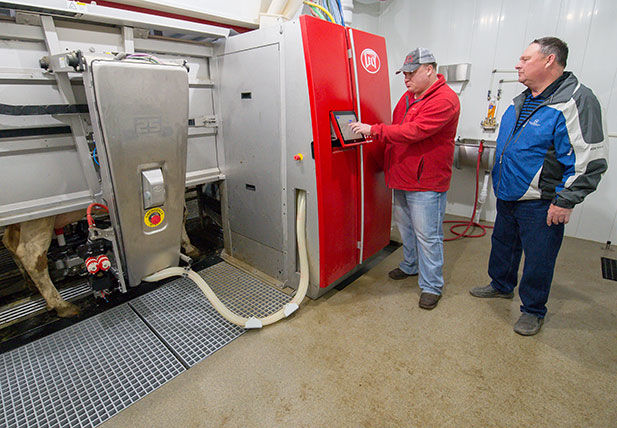 Smaller dairy operations are starting to take advantage of an impressive new age of technology.
Smaller dairy operations are starting to take advantage of an impressive new age of technology.
At a dairy farm just north of Creston, for example, the Robert Larson family farm can point to a state-of-the-art milking barn equipped with four robots that do the kind of work that used to require manual labor.
The robots’ job is to milk the farm’s 240 dairy cows. Each robot milks 60 cows about three times per day — depending on how much milk each cow is producing at the time.
The robots work by attracting cows to the unit by leaving out feed. A cow can voluntarily enter several times per day. The robotic equipment then locates the cow’s teats, clean them, and attaches properly to begin the milking process.
It takes some time for the dairy cattle to learn the new process, so milk production temporarily can be a bit off until they’re used to the robotic equipment.
The automated farm is the third of its kind in Nebraska, said Walter Aschoff, the owner and president of Aschoff Construction of Osmond — the contractor that built the barn for the Creston operation. One of the others is the Bill Demerath dairy of rural Plainview.
The main benefit of installing dairy robots is not to save money, but rather save schedule time and, as a result, improve the quality of life for dairy farmers.
Aschoff said the robots allow Larson and his family to schedule their free time to do things off the farm.
But it’s also important to note that the equipment is beneficial to the cows, too, because they are able to be milked on their own schedule.
“It’s like cage-free chickens,” Aschoff said. “It’s about the best the cow can get, and it’s good for the dairy man as well to get some time away from their dairy.”
Robotics are mainly being implemented on smaller dairy operations, Aschoff said. It’s because smaller operations can see the financial and time-scheduling benefits, and always can expand in the future.
Even so, Nebraska is behind the curve when it comes to robotic dairy farms. While the Larson dairy is the third in Nebraska, there are hundreds already in place elsewhere across the country, Aschoff said.
In particular, Iowa, Minnesota and Wisconsin have large numbers of automated and robot-equipped dairy farms.
What’s more, the United States, as a whole, is still behind some other nations. A Netherlands-based agriculture manufacturer, which specializes in robotic milking machines, estimates that 2 percent of dairy cows in the U.S. are milked using robots. By comparison, that number is about 30 percent in the Netherlands.
“We’ve been a little bit slow to the game,” Aschoff said.
Although the Larson farm is one of the few of its kind in Nebraska for now, automation and robotics are already an accepted way of life in the dairy industry.
Aschoff said robots have been around a long time on dairy farms. Milking machines and robots have been commercially available since the early 1990s, and started to enter the U.S. in the early 2000s. The numbers have climbed in the past decade and will continue to do so, he said.
“Eventually, driven by the necessity of it, we’ll have milking robots even in standard milking parlors — doing some tasks, if not all of them. This is just the first step into it,” he said.
Dairy equipment suppliers estimate that by 2025, up to half of all dairy cows in the U.S. will be milked by machine.
Aschoff said that while it’s the first robotic dairy barn he’d built, he expects more to come and that the dairy industry may see an expansion in Nebraska.
“Dairy and livestock are very important to this state,” he said. “We (Aschoff Construction) are very passionate about dairy, and hope to work with many more dairymen.”









